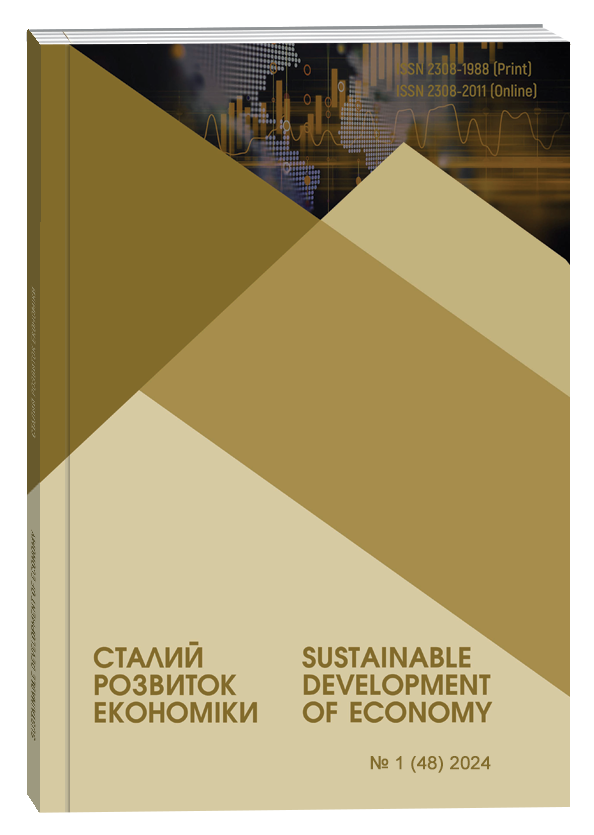FORECASTING OF THE PROBABILITY OF A FINANCIAL CRISIS AT THE ENTERPRISE
Abstract
The article is devoted to current issues of forecasting the probability of a financial crisis at the enterprise. The necessity of studying crisis phenomena at the enterprises of the cement industry in Ukraine, which are of great strategic importance in modern conditions for ensuring defense capability of the state, is determined. A list of the main groups of enterprises in the cement industry was compiled, taking into account the operating enterprises and enterprises that have suspended their activities, including due to being in the zone of active hostilities. The use of a logistic model for diagnosing the destabilization of the stable state of enterprises is proposed. A set of traditional and non-traditional prognostic parameters of the logit- model, which characterise various aspects of the enterprise activity, including its individual characteristics, features of corporate management and operating conditions, was determined. The following factors were chosen as non-traditional parameters of the model: membership in a corporate management group, city competitiveness index, and entering the TOP-100 rating of the largest companies in Ukraine. A correlation-regression analysis was carried out to build a logistic regression equation, in the course of which, using the principle of excluding the less significant coefficient from the matrix of paired correlation coefficients, the final predictors of the model were selected: the ratio of own working capital, the ratio of financial stability, the ratio of profitability of sales, the ratio of long term borrowings. The inappropriateness of the free term in the equation was determined. This is due to the fact that when all the final predictors take a zero value, the enterprise is inactive, and the assessment of the probability of a financial crisis depends only on the value of the free coefficient. A model for predicting the probability of a financial crisis at the enterprises of the cement industry of Ukraine has been developed. A scale for determining the appropriate level of risk depending on the obtained value of the event probability has been proposed.
References
Altman E.I. Financial Ratios, Discriminant Analysis and the Prediction of Corporate Bankruptcy. The Journal of Finance. 1968. No. 4. P. 589–609.
Ohlson J. A. Financial Ratios and the Probabilistic Prediction of Bankruptcy. Journal of Accounting Research. 1980. Vol. 18. No 1. P. 109–131.
Терещенко О.О. Антикризове фінансове управління на підприємстві: монографія. Київ : КНЕУ, 2004. 268 с.
Матвійчук А.В. Нечіткі, нейромережеві та дискримінантні моделі діагностування можливості банкрутства підприємств. Нейро-нечіткі технології моделювання в економіці. 2013. № 2. С. 71–118.
Добровольська О.В., Рондова М.А. Прогнозування банкрутства як методу оцінки фінансового стану підприємства. Агросвіт. 2021. № 20. С. 40–45. DOI: https://doi.org/10.32702/2306-6792.2021.20.40
Савченко М., Свінціцька Л. Удосконалення антикризової діагностики агропромислових підприємств. Адаптивне управління: теорія і практика. Серія Економіка. 2023. Випуск 15(30). DOI: https://doi.org/10.33296/2707-0654-15(30)-14
Асоціації виробників цементу України. URL: http://ukrcement.com.ua/ (дата звернення: 20.01.2024).
Модуль аналітики відкритих даних. Clarity Project. URL: https://clarity-project.info/ (дата звернення: 20.01.2024).
Індекс конкурентоспроможності міст України. URL: http://www.ier.com.ua/ua/mci (дата звернення: 20.01.2024).
Журнал Forbes Ukraine. URL: https://forbes.ua/ (дата звернення: 20.01.2024).
Altman E. I. (1968) Financial Ratios, Discriminant Analysis and the Prediction of Corporate Bankruptcy. The Journal of Finance, no. 4, pp. 589–609.
Ohlson J. A. (1980) Financial Ratios and the Probabilistic Prediction of Bankruptcy. Journal of Accounting Research, vol. 18., no. 1, pp. 109–131.
Tereshchenko O. O. (2004) Antykryzove finansove upravlinnia na pidpryiemstvi: monohrafiia [Anti-crisis financial management at the enterprise: a monograph]. Kyiv: KNEU, 268 p. (in Ukrainian)
Matviichuk A. V. (2013) Nechitki, neiromerezhevi ta dyskryminantni modeli diahnostuvannia mozhlyvosti bankrutstva pidpryiemstv [Indistinct, neural network and discriminative models for diagnosing the possibility of bankruptcy of enterprises]. Neiro-nechitki tekhnolohii modeliuvannia v ekonomitsi, no 2, pp. 71–118. (in Ukrainian)
Dobrovolska O. V., Rondova M. A. (2021) Prohnozuvannia bankrutstva yak metodu otsinky finansovoho stanu pidpryiemstva [Forecasting bankruptcy as a method of evaluating the financial condition of an enterprise]. Ahrosvit, no 20, pp. 40–45. DOI: https://doi.org/10.32702/2306-6792.2021.20.40 (in Ukrainian)
Savchenko M., Svintsitska L. (2023) Udoskonalennia antykryzovoi diahnostyky ahropromyslovykh pidpryiemstv [Improving of the anti-crisis diagnostics of agricultural enterprises]. Adaptyvne upravlinnia: teoriia i praktyka. Seriia Ekonomika, no 15(30). DOI: https://doi.org/10.33296/2707-0654-15(30)-14 (in Ukrainian)
Asotsiatsii vyrobnykiv tsementu Ukrainy [Association of cement producers of Ukraine]. Available at: http://ukrcement.com.ua/ (in Ukrainian)
Modul analityky vidkrytykh danykh. [Open data analytics module]. Clarity Project. Available at: https://clarity-project.info/ (in Ukrainian)
Indeks konkurentospromozhnosti mist Ukrainy [Ukrainian Cities Competitiveness Index]. Available at: http://www.ier.com.ua/ua/mci (in Ukrainian)
Zhurnal Forbes Ukraine [Forbes Ukraine magazine]. Available at: https://forbes.ua/ (in Ukrainian)


